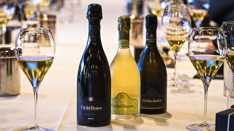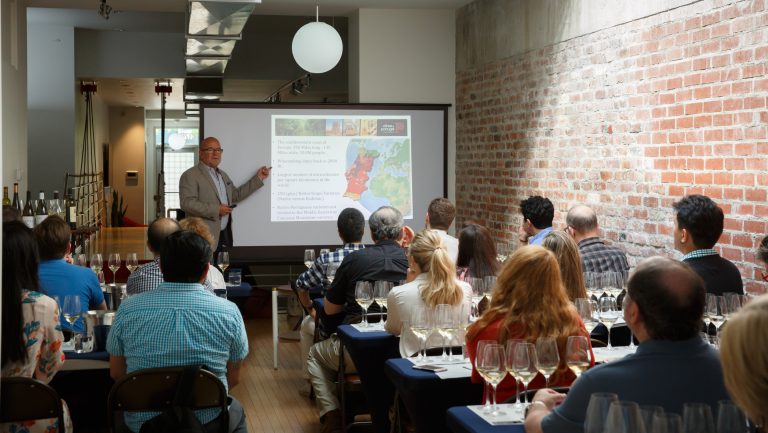This advertising content was produced in collaboration with SevenFifty and our sponsor, Santa Margherita USA; it does not necessarily reflect the views of SevenFifty Daily’s editorial team. For more information, please refer to our ethics guidelines.
In 1961 in Brescia, Lombardy, the first bottles of what would quickly become the area’s signature traditional-method sparkling wine—and one of the world’s most renowned—was released by Guido Berlucchi. A blend of Chardonnay, Pinot Nero, and Pinot Bianco, it was a northern Italian take on the grapes and ambitions of northern France’s Champagne. Six years later, in 1967, the Franciacorta denominazione di origine controllata (DOC) was established. It defined a new international-minded effort, and not simply a local tradition, with an especially rigorous production method and a specifically Italian expression—complexity through ripe fruit and intense autolytic character. Franciacorta’s denominazione di origine controllata e garantita classification was established in 1995 and applies exclusively to the region’s sparkling wines. Today the DOCG encompasses 116 producers making 17.5 million bottles a year.
“Franciacorta provides us with some of the most serious sparkling wines for our restaurants,” says Jason Goldsmith, the Chicago-based beverage manager of Eataly North America. “At Eataly,” says Goldsmith, “we think of Franciacorta as a perfect example of the biodiversity of Italy and the range of styles of sparkling wine available within her borders.”
Bringing History and Terroir to the Menu
Notable wine has been made in the Franciacorta wine region since at least the 16th century, when a Brescia physician promoted the purported health benefits of locally made bottle-fermented sparkling wines. A 19th-century review of the area’s white wines deemed them “excellent, rich, and elegant.” These days the area’s still wines—Chardonnay-based whites and red blends of Merlot, Cabernet Franc, Cabernet Sauvignon, and Carménère—have their own denomination: Curtefranca DOC.

Don’t miss the latest drinks industry news and insights. Sign up for our award-winning newsletters and get insider intel, resources, and trends delivered to your inbox every week.
Lying at the northern end of the Po Valley, whose warmer temperatures the zone shares, Franciacorta’s landscape forms a sweeping amphitheater whose climate is moderated by Lake Iseo, an area where rainfall is the most abundant, as well as nearby mountains and the wind-bearing Oglio River. Franciacorta soils are generally morainic, formed by the movement of glaciers during the ice age. There’s good drainage and good water retention throughout, but the zone features such extreme topographical and geological complexity that it’s subdivided into six distinct profiles. From east to west, harvest times can differ by up to a week, while acidity levels, fruit and floral notes, and levels of dry extracts are particular to each profile.
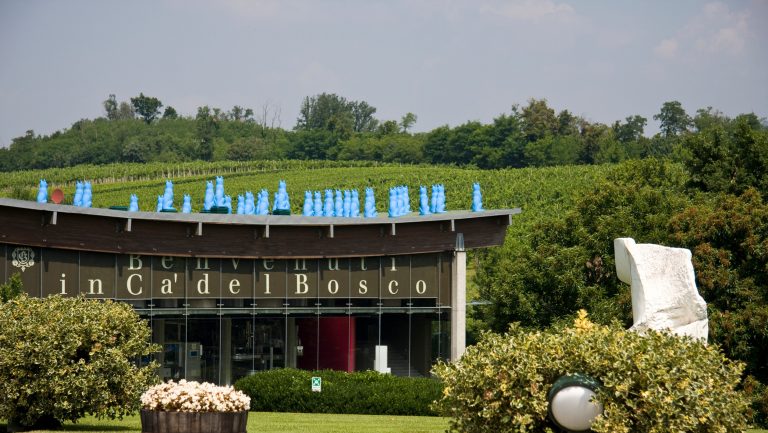
The DOCG has strict growing requirements, including a maximum vineyard elevation of 550 meters, a vine density of at least 4,500 vines per hectare in all but the steepest sites, and a maximum yield of 65 hectoliters per hectare. Hand harvesting is also required. All grapes—except Pinot Nero destined for rosé—are required to be direct-pressed, without destemming. Blending is an art form here: Varieties are vinified separately, as is the production of various vineyards, with precise cuvée techniques. Nonvintage blends include reserve stocks. Additionally, all wines must undergo a secondary fermentation in bottle.
Across the U.S., top sommeliers rely on Franciacorta to make their lists more dynamic, and they cite the producer Ca’ del Bosco, whose first vineyards were planted in 1968, as a benchmark. “It’s not difficult to recommend a Ca’ del Bosco Vintage Collection Dosage Zéro 2001 for $175 to guests who are looking for a vintage Champagne from a small grower and have a [relatively] limited budget,” says Mariarosa Tartaglione, the wine director of the Michelin-starred Ai Fiori in Manhattan. Goldsmith of Eataly agrees. “The Dosage Zéro has become a wine team favorite,” he says. “Powerful and structured, with a purity of fruit, it has quality that often surprises our guests … At Eataly, our job is to tell stories. Ca’ del Bosco is a shining example of a winery that helps us tell the story of Franciacorta; that the founder of the estate is still at the helm as the driving force of the winery is a compelling tale.”

Metodo Ca’ del Bosco
From its beginning, Ca’ del Bosco’s story has been one of innovations, says Maurizio Zanella, the founder of Ca’ del Bosco, whose first traditional-method release was the 1978 vintage. “From 1910 to 1960,” says Zanella, “Italian wine was more about quantity than quality and was used as food, because there wasn’t anything else to eat, besides bread. The two wars and immigration nearly destroyed the tradition of quality winemaking by small producers [in the area].” After a trip he made when he was 17 to the winemaking regions of France, which included time in Burgundy and a stop at Domaine de la Romanée-Conti, Zanella saw a different approach to viticulture and an opportunity to go in a completely different direction with winemaking in Franciacorta. This memorable trip was a catalyst in the founding of Ca’ del Bosco.
In 1979, Zanella recruited the French winemaker André Dubois, who at the time had been working for Moët & Chandon. With Dubois on board, another vision of what Franciacorta could be began to emerge: Terroir-focused winemaking that combined low-intervention growing practices in the vineyard with ongoing technological development in the cellar that could help reestablish the lost viticultural heritage.
Zanella converted to organic viticulture in the early ’90s, though there wasn’t a lot to change. “I never put one gram of herbicide or chemical fertilizer into Ca’ del Bosco,” he says. “We had only used [disease] treatments, and we stopped. It wasn’t a quality decision. The product is the same, but in terms of protecting our asset—the earth—it makes sense.” There was one drawback to organic certification: The copper sprays that were required for organic disease management remained on grape skins, leading to off odors in the cellar.
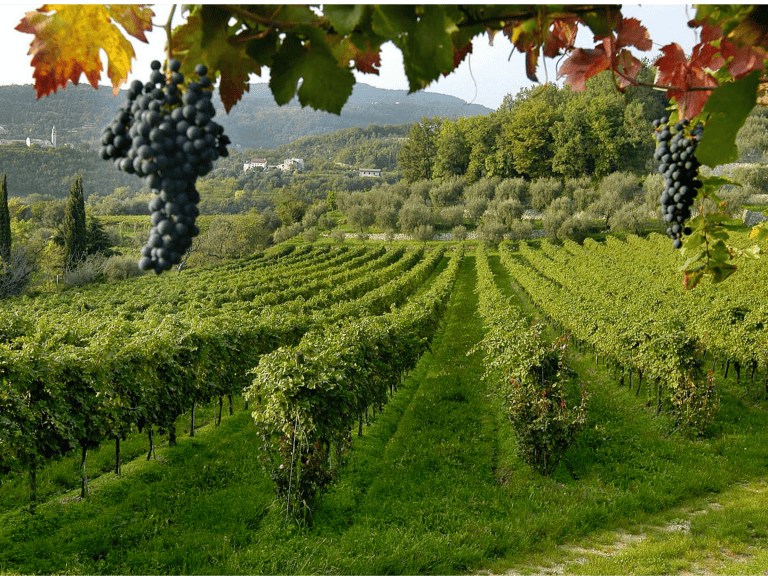
Santa Margherita
As one of Italy’s largest family-owned wine producers, Santa Margherita has developed a reputation for excellence across a diverse range of prominent wine regions.
“So,” Zanella says, “we thought of what your grandmother told you to do before you ate fruit.” In 2007 the vintners began to experiment with washing (and gently drying) their grapes, and by 2008, lab tests confirmed that a five-minute pass through the winery’s washing system eliminated up to 90 percent of the copper residue. Today the Metodo Ca’ del Bosco involves chilling the grapes after harvest, hand-selecting, and using an exclusive air-bubble bunch-washing system that incorporates three soaking vats to clean the grapes. The grapes are then crushed without oxygen and fermented in small oak barrels or vats.

In 2013, Zanella made use of another benefit conferred by the washing method: “We found out we didn’t need to use sulfites or débourbage [letting the solids settle before fermentation]. We can leave the wines on the total lees, which give a richness to the final wine. Everyone thought we were crazy, but now you can [sense] the difference between a Ca’ del Bosco and another Franciacorta. You lose bitterness; you add complexity.” Beginning with the 2014 vintage, Ca’ del Bosco has worked its entire production this way, relying on washed grapes and wines left unracked for both signature richness and total sulfur dioxide below 53 milligrams per liter, which is less than one-third of the legally mandated 185 milligrams-per-liter maximum.
An Alternative to Champagne
On Ai Fiori’s list, Franciacorta has its own dedicated section. “On an Italian wine list, Franciacorta is a must,” says Tartaglione. “With its expensive production method, severe rules, and low yields, [Ca’ del Bosco has made] a brave quality choice that deserves to be supported. As sommeliers in high-end international restaurants, our role is to help guests discover these wines. I’m not scared to recommend a Cuvée Annamaria Clementi 2004 for $320 to first-class-Champagne lovers.”
The Cuvée Annamaria Clementi is Ca’ del Bosco’s flagship Franciacorta Riserva bottling. Its base wines are created exclusively with free-run juice from Chardonnay, Pinot Bianco, and Pinot Nero grapes. Fermentation and maturation take place in small oak casks. The wine matures on its lees for an average of nine years, and there is zero dosage at disgorgement.
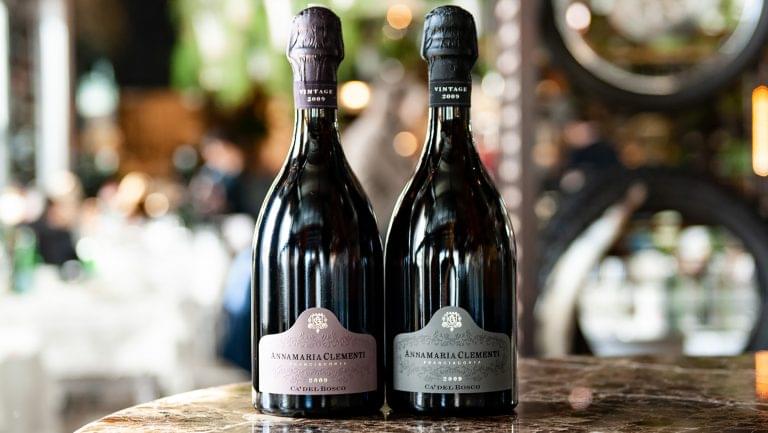
While the original inspiration—Champagne—can help explain Franciacorta wine, the distinct traits of the wine let it stand on its own: structured ripe fruit underscored by extended time on lees, from a minimum of 18 months for Blanc NV, compared with Champagne’s minimum requirement of 15 months, to at least 60 months for Riserva. Ripeness is a defining characteristic. As with Champagne, labels of Franciacorta’s wines are legally forbidden by the DOCG from including the term sparkling.
“I would put the Annamaria Clementi in the class of tête de cuvée Champagnes,” says Sarah Clarke, the beverage director at Mozza Restaurant Group in Los Angeles. “It has lots of minerality, a pleasant amount of fruit, especially golden apple, and that classic biscuity quality. There is tremendous value in Franciacorta.” Of the 24 wines given the top Tre Bicchieri award in the 2019 Gambero Rosso guide, 9 are Franciacorta, and the only winery to receive more Tre Bicchieri awards than Ca’ del Bosco is the Barolo producer Gaja.
“Champagne is different from Franciacorta,” says Zanella. “The first big difference is that we don’t need more sugar in the liqueur d’expédition. Our maximum is 4 grams, whereas in Champagne the average is between 8 and 10. It makes Franciacorta easier to pair with food because the wine is round and doesn’t have this contrast between high acidity and sugar.” Particular to Franciacorta, too, is the Satèn typology: a maximum of 5 atmospheres of pressure always dosaged to Brut for a smoother texture.
Franciacorta—and Ca’ del Bosco, in particular—can take ambitious lists one step further. “In our by-the-glass program, Franciacorta hits that spot between Prosecco and Champagne,” says Ai Fiori’s Tartaglione. “We recommend it as that $5 dollars more that gives guests the value they’re looking for.” Mozza’s Clarke employs a similar strategy: “We proudly pour Ca’ del Bosco Cuvée Prestige by the glass at Osteria Mozza.”

Dispatch
Sign up for our award-winning newsletter
Don’t miss the latest drinks industry news and insights—delivered to your inbox every week.



